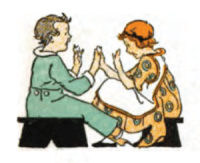Pin the tail on the donkey

Pin the tail on the donkey is a game played by groups of children. The earliest version listed in a catalog of American games compiled by the American Game Collectors Association in 1998, is dated 1899, and attributed to Charles Zimmerling.[1]
It is common at birthday parties and other gatherings. A picture of a donkey with a missing tail is tacked to a wall within easy reach of children.[2] One at a time, each child is blindfolded and handed a paper "tail" with a push pin or thumbtack poked through it. The blindfolded child is then spun around until he or she is disoriented.[2] The child gropes around and tries to pin the tail on the donkey. The player who pins their tail closest to the target, the donkey's rear, wins.[2] The game, a group activity, is generally not competitive; "winning" is only of marginal importance.
The game is also used in child development research.[3]
The game can also be played by teenagers and adults, especially if the "donkey" is replaced with depictions of something or someone else. As a drinking game, the person with the worst tail pinning is awarded one shot of a selected alcohol, to be determined by house rules or the loser in a friendly environment.
Idiomatically, the term can be used derisively for any assigned activity which is pointless or for which a person has been handicapped (blindfolded).
See also
External links
References
- ↑ http://gamecatalog.org/gc/printed/gc8.pdf The Game Catalog, 8th Edition, October 1998 - Page 89
- ↑ 2.0 2.1 2.2 Joanna Cole; Stephanie Calmenson; Alan Tiegreen (2004). Pin the Tail on the Donkey. Chronicle Books. pp. 8–9. ISBN 1-58717-230-5.
- ↑ Kagan, Jerome; J. Steven Reznick, Nancy Snidman, Jane Gibbons and Maureen O. Johnson (December 1988). "Childhood Derivatives of Inhibition and Lack of Inhibition to the Unfamiliar". Childhood Development (Blackwell Publishing) 59 (6): 1580–1589. doi:10.2307/1130672. JSTOR 1130672.
